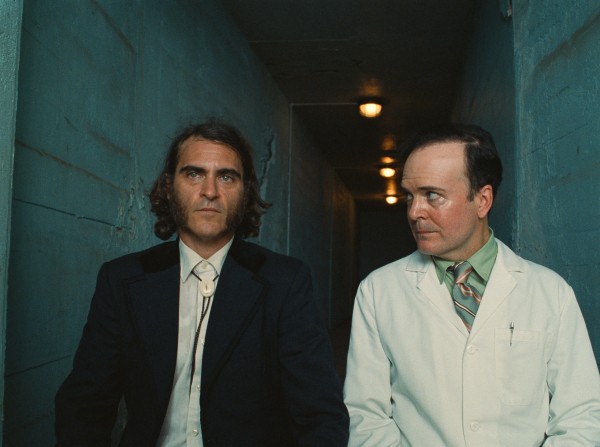As much as there was excitement for Paul Thomas Anderson’s 2015 release; with its much beloved source material and striking neon poster; the trailer for Inherent Vice was one of the clumsiest in recent memory. It left many intrigued as to what exactly the movie was going to be like and actually seeing it shed very little light on the matter.
Inherent Vice seemed at once to be a comedy and a drama with no in-between; its trailer featured a quaint but bizarre voiceover wishing its lead character good luck on his quest and several jarring pace changes from romp to drama to feel-good-film-of-the-summer. Intercut amongst brooding shots of lead Joaquin Pheonix were jokes as hit and miss as the new Jason Bateman release.
As many anticipated, the film itself is finely acted and directed and blessed with a gorgeous soundtrack of psychedelia and soul, but the trailer was burdened with a task as hard as summarising the movie in review form; encapsulating the feel, garbled narrative and tone of one of the most unique movies in years. Nothing else is quite like Inherent Vice, and while watching such a masterfully shot piece this sometimes feels like a damn shame, at other times you can only think ‘thank god.’
What Anderson does succeed in is capturing the mood and freedoms of new-decade California, and its fruitful stoner subculture. Many felt that American Hustle failed to live up to its promise of an all-out seventies romp, but thankfully, Inherent Vice very much lives up to the decade’s bold legacy. Although Hustle existed as a prelude to the 80’s and Vice exists in the fading light of the 60’s, it remains 148 minutes of flower power garishness and what comes across as a one-film push for a sandal revival.
The production of the movie is top to toe exquisite. Walls are lined with lilac shag-carpet, the hallowed surf is sunlit, contemplative and spiritual. It seems apt to describe Inherent Vice as a noir film despite its visual garishness as often, particularly in Doc’s seaside shack, its palette is one that appears to have had its natural colour removed and bright neon injected back in. Sometimes whole scenes go by without a glimpse of natural skin tone; instead jaded blues and reds fill the shapes, blurred of course by incessant piping smoke.
The set and costume design feel meticulously researched and shines best in the image of Pheonix as Doc, who, with colossal sideburns (think Bradley Wiggins turned up to 11) and varying styles of lions-mane hair, is instantly iconic and well utilised by Anderson. It’s easy to see why some have already proclaimed Inherent Vice a cult-classic; its style is certainty niche enough to fit that role. Furthermore, Phoenix is great as the eccentric lead Doc. In the wake of the confusing I’m Still Here mockumentary, he has returned as a prominent Hollywood voice having put in a mesmerising turn in Spike Jones’ fantastic Her and in James Grey’s The Immigrant. Inherent Vice sees him continue this renaissance, with a perfectly pitched befuddlement and his own brand of hippy charisma. The flaws of the movie aren’t with its style then, but its message.
One might leave the theatre scratching their head in search of some meaning amongst all the philosophising. But while there were too many poignant musings to dismiss it as meaningless, the film is simply too incohesive in this regard to naturally draw together any form of conclusion. Its ideas come in the form of sketches and vignettes but just as the film exists in a haze of neon and cannabis smoke, its designs too, are hazy and incomplete. At first it comes off as dense, perhaps impenetrable, but by the time the credits roll it’s sort of clear (nothing is crystal when it comes to this movie) that there was no message, despite its attempts to feign one.
At times it seems like a solid satire; John Brolin’s Detective ‘Bigfoot’ is introduced as a hater of hippy scum and a man with ‘a penchant for civil rights abuses’ while another character describes Eric Robert’s Mickey as ‘technically Jewish but wants to be a Nazi.’ But just as there are these moments of genuinely sharp satire on hate groups like the Aryan brotherhood or police brutality or the decline of the hippy movement or brothels disguised as Taiwanese massage parlours, these quips come too scattershot to proclaim the movie to be a satire on any of them.
Worse still is a base lack of cohesion in the film’s narrative. So frequently are you left clueless as to who a character is or what role they have to play in what was apparently three separate PI cases (a fact I was clueless of before looking it up) that this sense of humour simply muddied the water. One of the main causes of this is Vice’s aural quality. Dialogue was often hidden behind a bustling setting and lively score, accompanied by the fact that the delivery was often as mumblecore levels of hush, and key moments were simply lost in the mix. When you can’t make out what is being said in the pivotal first scene, this is a major issue.
Unsurprisingly then, the film’s narrative shines best when it is single-minded in vision, and this shines in the failed-romance between Doc and his ex-girlfriend, Shasta Hepworth. It’s most touching and contemplative moment comes when a Ouija board tells the pair where they can find some pot in the dry days of 1969, and although they naturally don’t find any, they do find a moment of clarity in the hour they share together. Another striking scene, probably the film’s best, comes when Shasta makes a return to Doc, undresses and seduces him; the emotions on display consistently built throughout and stripped bare before us, quite literally, and it’s a moment that possesses as much tension as many a thriller’s culmination. It’s a shame few strands of the movie came together so sharply.
Later in the same scene Shasta explains how she was brought along on a three hour tour ‘as the inherent vice.’ Doc asks what that is and ‘I don’t know’ is her reply. While perhaps it was meant to be a wry moment, the line smacks more of a film drowning in a lack of narrative direction. This is supposedly a wry acknowledgement of the fact, perhaps in a last ditch attempt to make it appear intentional. Either way, it makes for a film that is often too frustrating to enjoy fully. By way of explanation: ‘inherent vice’ is the tendency of something to disintegrate based on its internal component’s natural instability, which makes it an apt descriptor for the film it titles.
Phoenix puts in yet another great performance in a film that has a good sense of humour and is artistically inspired, with a sense of place more precise than any film in the past year. But for a lot if its duration it’s hard not to wish the drive of the plot and the strength of its ideas were conveyed as clearly, for alas they played second fiddle here. Perhaps on repeat viewings some cohesion may arise but for now, sadly, the movie’s inherent sense of confusion was its greatest vice.
6/10
Liam Inscoe-Jones
Click here for more of the latest Film Reviews
Get in touch with us via Facebook and Twitter, or leave a comment below.


















